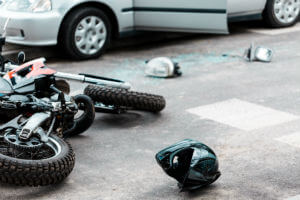 Bad weather is often unexpected. When it hits, it may put a damper on your plans for a motorcycle ride. Fortunately, there are some ways you can prepare yourself for getting caught in the rain, which puts you at greater risk of losing control of your bike and crashing into objects or other drivers. Below, we discuss ways to help you stay safe in these conditions.
Bad weather is often unexpected. When it hits, it may put a damper on your plans for a motorcycle ride. Fortunately, there are some ways you can prepare yourself for getting caught in the rain, which puts you at greater risk of losing control of your bike and crashing into objects or other drivers. Below, we discuss ways to help you stay safe in these conditions.
If you or someone you love has suffered an injury in a motorcycle accident it is important to contact a skilled South Bend motorcycle accident lawyer at Pfeifer, Morgan & Stesiak for assistance. We can explain your legal rights in a free, no-risk legal consultation.
Having the Right Gear
It is important to gear up and prepare yourself for any type of weather you may get caught in. Being exposed to rain can make your ride challenging as the road becomes slippery and your grip on your handlebars may be less sure. However, there are some items you can invest in to that will help you get through those unexpected downpours safely. These items include:
- A sturdy, rainproof jacket
- Reflectors
- Towel to dry off
- Extra pair of gloves
- Helmet with an anti-fog visor
- Change of clothes
Maintaining Your Bike
To safely get through the rain, you need to maintain your bike properly. This process starts with the inspection. Checking tires and tire pressure is often the first order of business. Worn tires need replacement. Check for any tears in brake pads. Inspect oil and brake fluid levels. The chain may also need adjustment to avoid complications with the rear wheel grip.
Any problems with these components could cause problems in rain and on wet surfaces, so it is important that you inspect your bike every few weeks and fix any problems you discover.
Operating Smoothly
It is crucial to be extra cautious during rainy weather because it is tougher for your tires to gain traction. Braking, acceleration and steering all require smoother operation to avoid slipping and sliding in the rain. This requires smoother throttle adjustments, less lean angles and gradual braking action.
Braking quickly can cause anti-lock brake systems to lock up in the wet weather. If not careful, you could hydroplane and end up in an uncontrollable slide. If braking hard is unavoidable, it is best to do so progressively.
Avoiding Shiny Surfaces
Shiny surfaces are usually wet. It is best to avoid these areas by finding the dry spots. Pacing, following, behind a car can keep you on a dry line, and help you avoid slipping. This can make turns a lot easier. Just make sure not to follow too closely.
Shiny surfaces can deceive you because they may conceal large holes in the road. Debris can seriously damage tires if you hit it because you cannot see it.
Taking a Break
Breaks are important if the driver gets too cold, wet or cannot see the road any longer. Sometimes, rain will come down heavily and then dry up in minutes. Other times, rain will last all day but is only heavy for a certain period of time. Breaks are also necessary when the driver starts feeling fatigued because of the wet and cold. Resting, even if only for a short period, can help revitalize the driver to safely finish the journey.
Speak to a Skilled Lawyer Today
After it rains, the roads are often slick, which can increase the chances of an accident. Here at Pfeifer, Morgan & Stesiak, we can help you through this ordeal. We can investigate the scene, communicate with the relevant insurance carrier and calculate compensation based on the damages involved in your case. We can also explain what types of compensation are available based on your unique incident.
We can determine if another party is at fault or discover if negligence is the reason for the incident. Our focus is on you, and we will assist you throughout the entire claim process.
Contact us today by phone at (574) 444-0741 for a free consultation.











